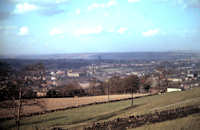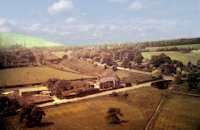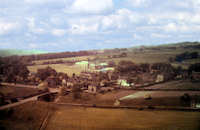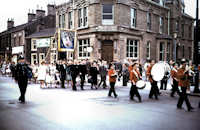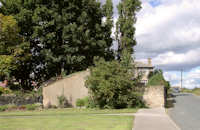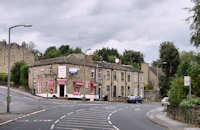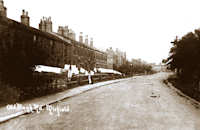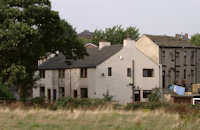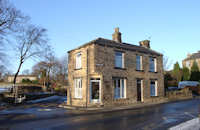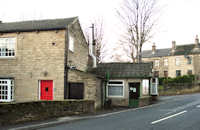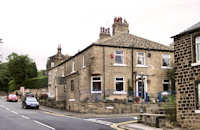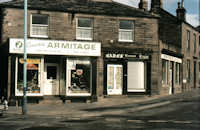The 1950s
The 1950s just happened to be the decade that provided the backdrop to my teenage years. After failing the eleven plus exam I went to Mirfield Secondary Modern School for one year. The headmaster was Mr. Bassett, a ginger haired man of whom we were greatly in awe. The headmistress was Mrs. Lockwood whose motto was 'If a job's worth doing, it's worth doing well' and she would have liked this to be the school motto also but didn't manage to get it past Mr. Bassett. The wearing of headscarves by the girls was banned by Mr. Bassett who called them pudding cloths.
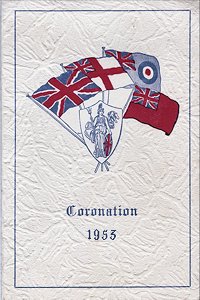
Courtesy of Carol Borg
It was during my time at Mirfield Modern School, February 6th 1952, just before my twelfth birthday that all pupils were called to a special assembly in the main hall late in the morning. I remember the moment that we all gathered and speculated at what was to be announced and I suddenly knew, although I still don't know how the thought came to me, that the King had died. Ordinary families like our didn't have television sets so I wasn't really aware of the poor state of King George's health but an assembly of the whole school had to mean that something momentous had occurred as indeed it had. When Queen Elizabeth II was crowned on 2 June the following year many children received photos in a Coronation mount as pictured on the right.
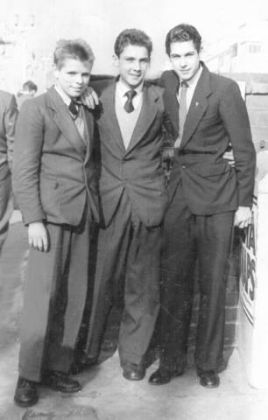
Michael Bridgewater, Kenneth Smith and Eric Ellis
Blackpool 1956
Three Kitson Hill Estate lads on a day trip to Blackpool in 1956. Michael Bridgewater on the left, Kenneth Smith in the centre and myself on the right. The coach trip was organised by Old Bank Bakery where Michael's granddad worked. We hit the Tower at one end of Blackpool, the Pleasure Beach at the other and all three piers in between. The photo was taken by one of the ubiquitous street photographers who abounded at any seaside resort at that time. I regarded them as a nuisance then but strangely miss them now that they have almost disappeared.
First Holiday Without Parents
Our first holiday without our parents saw us catching Joseph Wood's coach and arriving in Bridlington complete with our ridge tents. We had naively thought we could just turn up and camp out on the cliff tops but when we got there we found 'no camping' signs everywhere. Three of us had travelled by coach but the fourth, Robert Guy, worked on the railway so he had taken the train. We were such masters of organisation that it needed a miracle for us to link up in Bridlington but fortunately such a miracle happened and we bumped into Robert in an amusement arcade during a break from trying to find somewhere to camp on that first afternoon. We had no idea what to do and as it was already getting dark we had no time to find a camp site so we spent the first night in a barn with the farmer's permission. It turned into a good holiday after that when we found the Marston Road camp site next day. It was lucky that we had return tickets for the coach however because we ran out of money with two days still to go.
Ingoldmels 1958
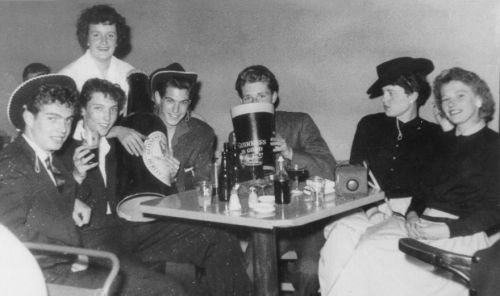
Brian, Kenneth, Betty, Eric, Robert, Shirley and Sylvia
Four lads on holiday at Ingoldmels, Lincolnshire in 1958. We were better organised this time and were, from left to right, my brother Brian, Kenneth Smith, myself, and Robert Guy for a whole week in a caravan. We managed to break one of the caravan windows through boyish exuberance and it made a large hole in our holiday money to get it repaired.
In a caravan in the next row to ours were three girls on holiday from Nottingham; what more could we wish for? They were Betty, Shirley, and Sylvia.There were few pubs outside of the town itself but there were clubs lining the seafront road and also on the holiday camps. It was a requirement of these clubs that you had to be a member for 24 hours before you could drink there so we took out temporary membership of as many as we could on the first day.
Brian and Betty won a Rock and Roll dance competition at one club and the prize was six cans of beer. Beer in cans was relatively new then and we didn't really trust it but we saw it off anyway.
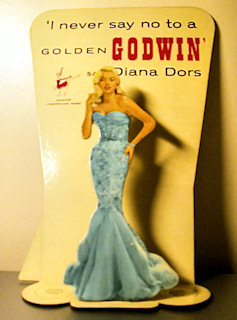
Diana Dors - Golden Godwin Advert
One abiding memory is of cardboard cutouts in the pubs depicting Diana Dors wearing a tight fishtail skirt with the slogan 'I never say no to a Golden Godwin'. Golden Godwin was a Babycham type drink. I owe a debt of gratitude to Paul Sullivan, author of the Official Diana Dors Archive and Website for granting permission to reproduce this advert here.
Diana Dors was born Diana Mary Fluck on 23 October 1931 and came to prominence as a glamorous actress in her earlier career. Her talent as a brilliant character actress largely came to the fore in her later years when her fading beauty allowed her to take on more serious roles which had previously been denied her when the focus had been on her beauty.
This actress was one of our greatest British talents until her death in 1984 and Paul's website, linked to above, is well worth a visit for anyone who remembers Diana and is especially valuable to those who may never have heard of her because the memory of this actress should never be allowed to die.
Mirfield Photos 1950s
I have recently been fortunate enough to come across a few photographs that were taken as slides in the 1950s by the former Grammar School teacher, Mr. Geoff Jones. These give a valuable insight into a Mirfield that has now disappeared into the past.
This view of Mirfield is taken from Upper Hopton. The Parish Church can be seen in the centre with Lyle's Ledgard Bridge Mills sprawed out lower down and the square block of the Britannia Mill building of the Coloured Cotton Spinning Company that stood on Station Road.
On the right is a view over Pinfold Lane taken from the top of the Parish Church tower in the 1950s. It offers a clear view of the Leeds New Line railway tracks as they run parallel to Crowlees Road. The leftmost brige carries Parker Lane and the one on the right is Pinfold Lane crossing the track. The agricultural land in the foreground is now completely given over to housing as is the land beyond Pinfold Lane and indeed the railway cutting itself has been filled in and built on. The red-brick house on Pinfold Lane was the home of Mr. W. Hepworth (headmaster of the Grammar School) and the late Mr. Barker (English master) lived in one of the stone houses near the bridge.
This is a similar view but shows the Grammar School and Westfields all the way to the Baptist Chapel on Water Royd Lane. All of the fields in this photo, with the exception of the ones directly to the front and rear of the Grammar School have been taken over by Dunbottle Close, Westfields, West Royd and Water Royd private housing estates.
The central and right part of the photo is Towngate and, of the old buildings that can be seen there, only the Towngate Working Men's Club building, the row of white cottages, Gomersal's cottages across the road, and Ivy Lodge on the corner of Crowlees Road remain. The rest of Towngate was cleared and new housing appeared all along it in the mid 1960s. Towngate Grove also appeared around this time and Pinfold Lane itself was lined with houses. The row of white cottages was converted into one house and has now had another house built in what was its garden.
This photograph shows the Baptist Chapel Whitsuntide parade led by their Brass Band and banner as they pass the Caxton Building in the centre of Mirfield during the 1950s. To the left of the bank is the Ex-Servicemen's Club.
Local Businesses That Are No More
It is nothing unusual for shops to change hands or be put to a different use or even to cease trading altogether but Mirfield had a plethora of small shops that we thought would always be there but sadly are now gone altogether. We had a Tobacconist and Marsden's Jewellers in the main run of shops from King Street and Mr. Mountain the hairdresser on the corner of King Street itself. The hairdresser's later became Bruce's Pet Shop when he moved from Nettleton Road where he had traded next to Binney's Fish Restaurant. Also on Eastthorpe was a little sweet shop next to Ramsden's Butchers that was run by two little ladies.
At the top side of the entrance to the Horseshoe yard in Leeds Road was a little wooden lockup shop that sold sweets and pop etc. and another was on Huddersfield Road close to the bottom of Coppin Hall Lane.
Situated on Crossley Lane just above Wellhouse Avenue was a tiny shop where we would call and buy a bottle of pop when we had been roaming around Crossley Bottoms on a hot summer's day. It had a raised flagged area in front of it and the door was to the right of its window. This gable end, shown in the photo, was the only evidence that it ever existed but has now been cleared and a house built on the site.
Further up Crossley Lane on the outside of the sharp bend where the footpath to Norristhorpe starts was Wood's bacon factory (now a farm). There were pig pens on the left hand end of the factory where the pigs were kept before slaughtering. I'll skip the details here to spare the squeamish but from there they were hoisted into the factory where machines hot-washed the carcasses and stripped off the body hair. The process continued until the meat products were ready to be shipped from the other end of the factory. I was inside the factory on a few occasions as I knew someone who worked there and I can assure you that the smell took some getting used to. You can read a description of a visit to the bacon factory in the 1957 issue of the Modern School magazine. I hear children today going along Crossley Lane saying that they are going to Piggy Woods and I wonder if they know that Piggy Wood was the nickname of the owner of the factory or if they are referring to the trees in Crossley Bottoms.
In Lee Green, just downhill from the Shoulder of Mutton, there is a three story building that had been a co-operative store but at this time was operating as a warehouse with lorries being loaded at the rear. On the opposite side of the road was Mr. Pattinson's green grocery business. He conducted his business from a wooden shop and also from a cart drawn by a white horse with which he would tour all over Mirfield to serve his customers. Just below Mr. Pattinson's was the Spice Boiler's shop run by Mr. Brearley. He had a counter just inside the door where he would sell his boiled spice and a large table in the centre of the room where he would roll out and cut the mixture. We loved the sugary smell inside his shop.
At the very bottom of Lee Green was the corner shop run by Ted Rands and his wife. They lived there with their son and daughter, Nelson and Greta, and sold everything from bread and groceries to cycle clips and tyres and even the "high tension" batteries for the old wireless sets of the day. The shop was later taken over by Eric and Doris Parker and subsequently passed through other hands but was up for sale at the time the photo on the left was taken in September 2001. It finally closed its door in 2004 and is now a private house.
For Sunday opening we had Mrs. Wood whose shop was in a mid terrace house in the row of houses just after the Methodist Chapel on Old Bank Road. This very old photograph shows the row of houses where the shop was. You were only allowed by law to purchase hardware items on a Sunday but Mrs. Wood was flexible so long as you were discreet. While we are on Old Bank Road I should perhaps mention the Lion Stores who sold general groceries and was a little further along on the same side where there is now a hairdresser's shop.
On the corner of Lee Green and Water Royd Lane, opposite the Saville Arms public house was Miss Jessie's shop (now William Hill's) selling general provisions. Her shop door was on what is now the back of the shop accessible from Lee Green and not on Waterroyd Lane as in now the case. Just along Water Royd Lane itself was Stout's Store (now a sandwich shop) which was another general grocer and very popular due to its proximity to Kitson Hill estate.
At Towngate, just at the bottom of Sous Lane, was the store and headquarters of Mirfield Perseverance Cooperative Society, the forerunner of the Food Fair. The loading bay was up the left side of the store giving access to the upstairs storage area and the manager, Mr. Alan Middleton in the 1950s and beyond, had his office at the right side of the building. The Secretary was Mr. Fred Pinder and his office was among the houses up the lane at the right where we would go to collect our dividend (divy) at the appropriate time of year. My mother was an early member of the coop as borne out by her coop number of 102.
On the front view, the main store filled the central and left parts of the building while the window and door at the right was for the hardware department. The photo shows an extra door to the left of the original one which was created when the building was converted to houses.
At the bottom of Camm Lane was the corner shop known as the tuck shop where the Grammar School kids used to buy crisps and drinks. We also used to get a ha'penny spanish and ka-li which was a sherbert type powder served in a small paper bag. You sucked the stick of spanish then dipped it in the ka-li which then stuck to it so that you would get the tingling sensation of the ka-li when you sucked again. This is now a house having closed several years ago. Also converted to a house is the corner shop at the bottom of Nab Lane.
Today we seem to have more than our fair share of Indian and Chinese takeaways along with a couple of Pizza Houses. Those among you who enjoy such exotic fair may rejoice in this fact but when I was growing up we were served by the good old fish and chip shop and old habits die hard.
For all of my life there had been a fish and chip shop on Greenside Road (pictured left) but when
the last owners retired at the end of 2003 it closed and then was finally demolished during 2005. It
was originally run by Jim Parkinson, who died in 1951, and was then sold to Albert Parker who ran it
until about 1955 when he moved to Old Bank Fisheries. The Greenside shop was then sold to Reddicks.
A fish shop near the Saville Arms was owned by Mr Weldrick and is now an Indian take away. Binnys Fish
Restaurant was situated near the bottom of Nettleton Road and later passed on to other owners but is now
no more. There was also a wooden hut fish shop at Northorpe just below the Plough Inn but this disappeared
many years ago. Fish shops that still survive, even though in different hands, are at Princess Street by
the Black Bull, Old Bank Fisheries (in my opinion the best for quality and value), Altys at the top of Nab Lane and until recently, Waterhouses next to the
Wilson Arms although at 2012 this is now an Indian takeaway. Later additions to this list are Wibits in
Eastthorpe and Ashcrofts at the junction of Greenside Road and Jenny Lane.
When I was living on the Kitson Hill Estate we were also visited by a mobile fish shop and also the pie and pea wagon. At the same time the ice cream man pulled his handcart single handed up to the estate from Crossley's ice cream factory at Ravensthorpe. He laboured between the shafts on the uphill stretches and fought the momentum of the cart on the downhill run. The hand cart gave way to the motor van a few years later but he still announced his arrival with a handbell.
This house at the junction of Nab Lane with Stocks Bank Road was once a corner shop. The window set into the corner of the building was the door to the shop before the conversion. During the 1960s the shop was run by Eddie Rigg, a former world class speedway rider, who was a local hero.
Any journey into the centre of Mirfield wasn't complete without us spending ages with our noses pressed up against the window of Laurie Armitage's cycle shop. This seemed the centre of the universe to us lads and had the very latest speed machines with their light-weight frames, drop handlebars and saddles narrow enough to cut you in half. This was the time when the Sturmy Archer 3 gear hubs were giving way to Derailleurs and double chainwheels were new technology. With the old Sturmy Archer you had to back pedal to change gear whereas the derailleur worked its magic while still pedaling for your life. A top of the range bike would have a 6 gear derailleur and a double chainwheel giving 12 gears in all, and then came the treble chainwheels... Laurie Armitage also had a shop in Ravensthorpe which was the headquarters for the cycle club. The photo is by the late Ian E. Gawthorpe and is reproduced with the kind permission of Christine Gawthorpe.
Local Pubs and Clubs that have disappeared
The Yewtree, Between The Three Nuns and the Horseshoe — now a private house.
The Robin Hood Inn, Far Common Road, opposite Fall Lane — now a private house.
The Bridge Hotel, Facing Ledgard Bridge on Calder Road, Lower Hopton — now flats.
The King's Head, Water Royd Lane, at Cripple Gate — demolished.
Nab Working Men's Club, Stocksbank Road, just above Nab Lane — now private housing.
Ex-Servicemen's Club (Soldiers and Sailors), opposite the Library in the centre of Mirfield — demolished.
Conservative Club, North Road — was Barclay's private club but now closed.
Towngate Working Men's Club, originally at Towngate then Dunbottle Lane — now demolished and The Old Colonial built on part of the site.
Marmaville, Church Lane — closed 30th September 2001 and the site has been used for luxury flats. The original facia has been retained and is now a feature of the development.
The Yorkshire Volunteer, Lower Hopton — Minimarket
The Wasp Nest, Nab Lane — Demolished for housing
The Freemason's Arms, Liley Lane — Apartments
The Black Bull, Eastthorpe — Tesco Express
The Swan, Shepley Bridge — Closed down and derelict for several years, finally demolished mid 2015
The Fountain, Leeds Road

click for larger photo
The Robin Hood Inn

click for larger photo
The King's Head
 click for larger photo
click for larger photoThe Horseshoe Inn
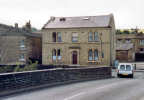
click for larger photo
The Bridge Hotel

click for larger photo
The Dusty Miller
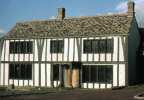 click for larger photo
click for larger photoThe Yewtree Inn
